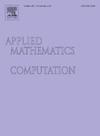矩阵加权网络上不同阶交换多智能体系统的一致性
IF 3.4
2区 数学
Q1 MATHEMATICS, APPLIED
引用次数: 0
摘要
研究矩阵加权网络上连续时间差分阶交换多智能体系统的一致性问题。分别针对二阶子系统和一阶子系统设计了新的共识协议。在设计的算法中,利用矩阵理论、变量变换和Lyapunov稳定性理论,采用两种方法获得了取决于网络拓扑结构、耦合增益和平均停留时间等因素的不同阶交换矩阵加权质量的一致性准则。本文章由计算机程序翻译,如有差异,请以英文原文为准。
Consensus of different-order switched multi-agent systems on matrix-weighted networks
This paper considers the consensus issue for continuous time different-order switched multi-agent systems over matrix weighted networks. A new consensus protocol is designed for second-order and first-order subsystem, respectively. Under the designed algorithm, utilizing matrix theory, variable transformation and Lyapunov stability theory, two methods are used to obtain the consensus criterion of different-order switched matrix weighted MASs, which depend on factors such as network topology, coupling gains, and average dwell time.
求助全文
通过发布文献求助,成功后即可免费获取论文全文。
去求助
来源期刊
CiteScore
7.90
自引率
10.00%
发文量
755
审稿时长
36 days
期刊介绍:
Applied Mathematics and Computation addresses work at the interface between applied mathematics, numerical computation, and applications of systems – oriented ideas to the physical, biological, social, and behavioral sciences, and emphasizes papers of a computational nature focusing on new algorithms, their analysis and numerical results.
In addition to presenting research papers, Applied Mathematics and Computation publishes review articles and single–topics issues.

 求助内容:
求助内容: 应助结果提醒方式:
应助结果提醒方式:


